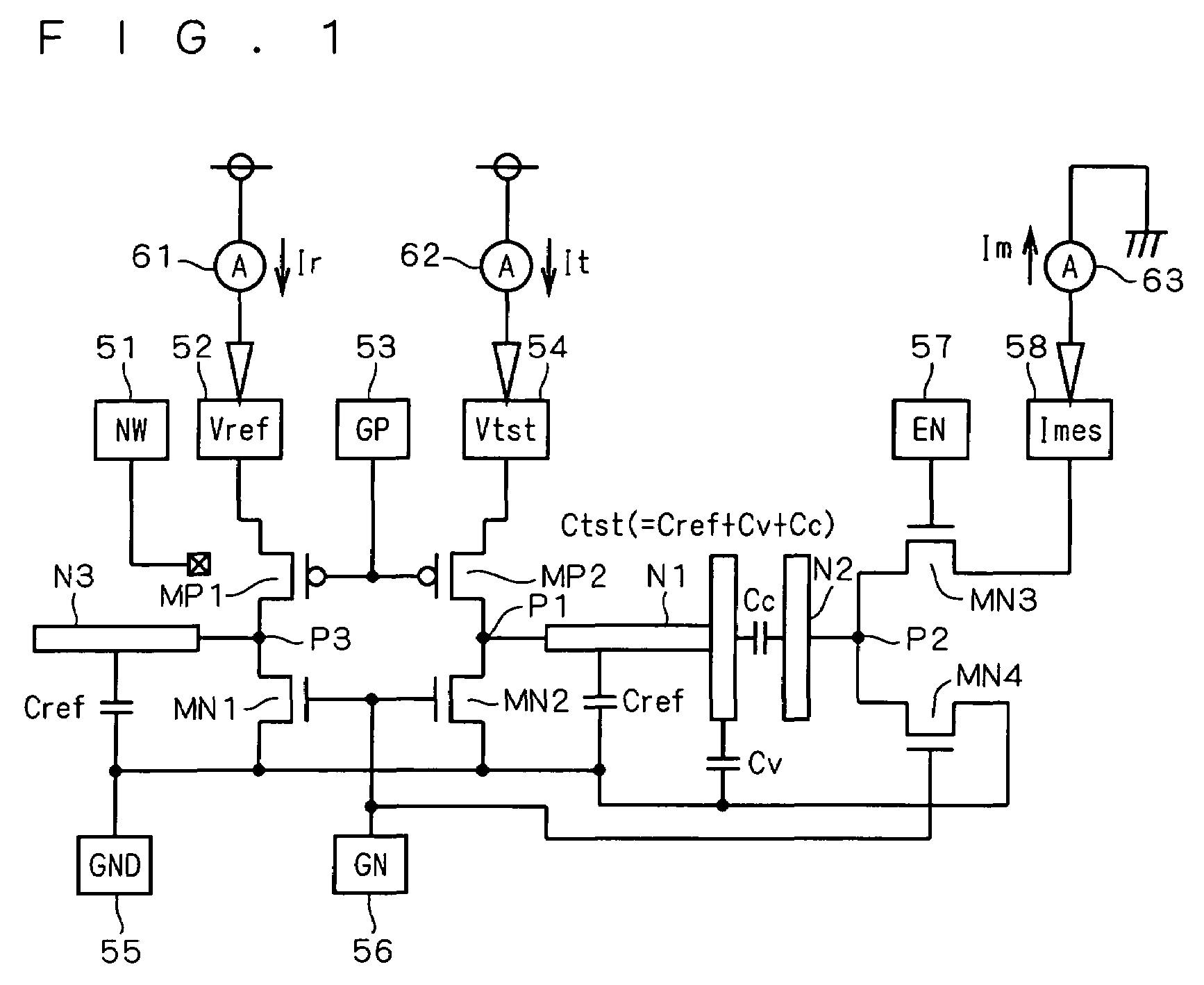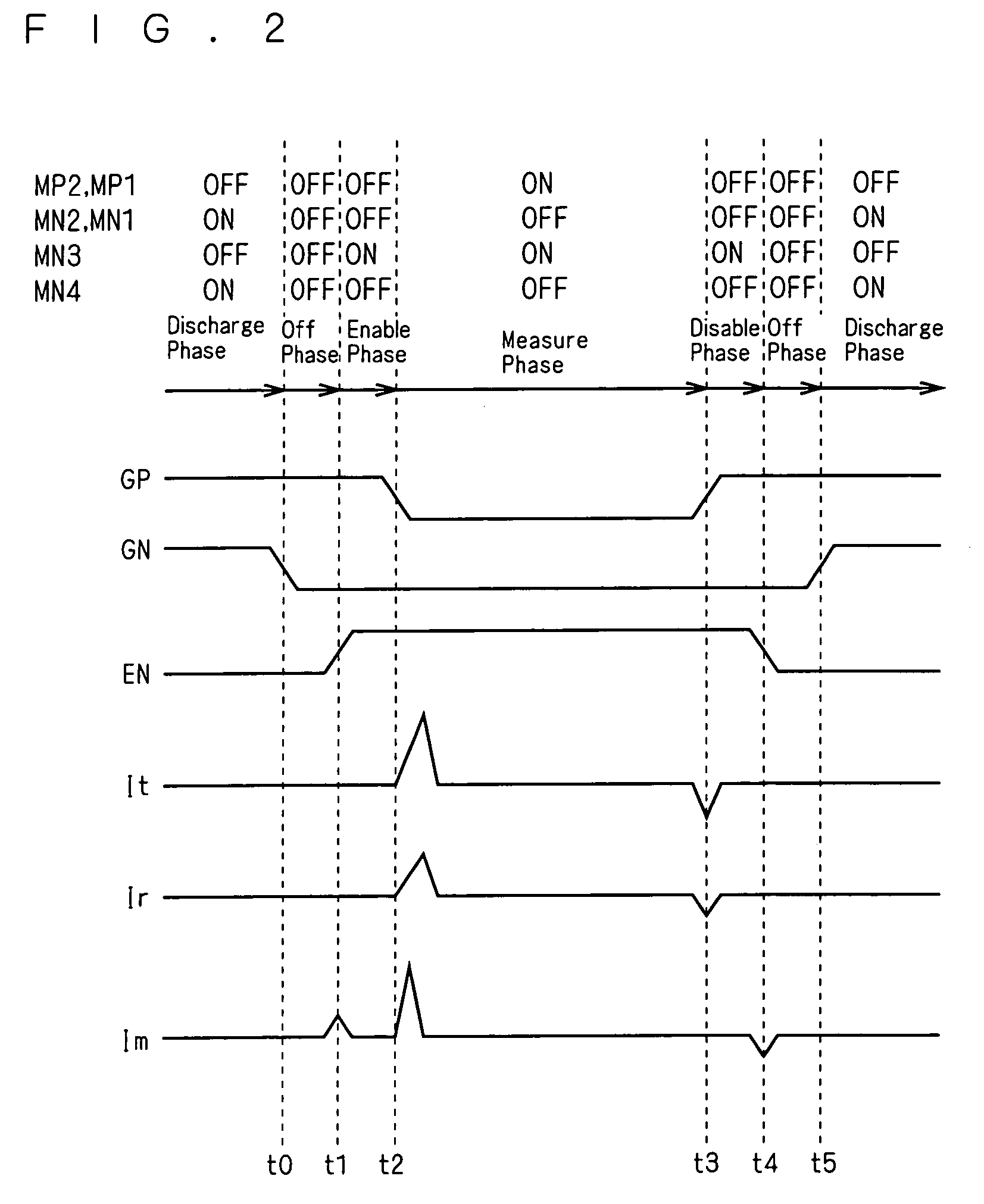Capacitance measurement circuit
a capacitance measurement and circuit technology, applied in the direction of capacitance measurement, resistance/reactance/impedence, instruments, etc., can solve the problem of difficult to separately measure each component of the measuring target capacitance, and achieve the effect of improving the verification accuracy of a circuit simulator using a ring oscillator
- Summary
- Abstract
- Description
- Claims
- Application Information
AI Technical Summary
Benefits of technology
Problems solved by technology
Method used
Image
Examples
second preferred embodiment
[0124]FIG. 5 is an explanatory diagram schematically showing, in relation to a well region, a configuration of a CBCM circuit according to a second preferred embodiment of the present invention. As shown in the drawing, the PMOS transistors MP1 and MP2 are formed in an N well region 32N, and the NMOS transistors MN3 and MN4 are formed in a P well region 32P. The potential of the P well region 32P is fixed at a P well ground potential PW by the pad 59. The other parts of the configuration are identical to those in the first preferred embodiment shown in FIG. 1 and thus not described herein.
[0125]FIG. 6 is a cross-sectional view showing cross-sectional configurations of the NMOS transistors MN3 and MN4 employed in the CBCM circuit of FIG. 5. FIG. 7 is an explanatory diagram simply illustrating a well structure of FIG. 6.
[0126]As shown in these drawings, a bottom N well region 31 is formed in the upper layer of a P-type substrate 30, and the P well region 32P and the N well region 32N ...
third preferred embodiment
[0132]FIG. 8 is a cross-sectional view showing a transistor structure employed in a CBCM circuit according to a third preferred embodiment of the present invention. As shown in the drawing, the NMOS transistors MN3 and MN4 are formed in an SOI (Silicon-On-Insulator) layer 43 of an SOI substrate which is formed of a P-type substrate 41, a buried oxide film 42 and the SOI layer 43.
[0133]In the SOI layer 43, N+ diffusion regions 44 and 45 are selectively formed. The gate electrode 37 is formed above the SOI layer 43 between the N+ diffusion regions 44, and the gate electrode 38 is formed above the SOI layer 43 between the N+ diffusion regions 45. The N+ diffusion regions 44 and the gate electrode 37 form the NMOS transistor MN4, and the N+ diffusion regions 45 and the gate electrode 38 form the NMOS transistor MN3.
[0134]The N+ diffusion region 44 (on the source side) is electrically connected through a contact hole 66 to the pad 55, the gate electrode 37 is electrically connected throu...
fourth preferred embodiment
[0139]FIG. 9 is a circuit diagram showing a configuration of a first circuit in a CBCM circuit according to a fourth preferred embodiment of the present invention. As shown in the drawing, a target capacitance forming part 91A for measurement of contact-to-gate capacitance is formed between the nodes N1 and N2. The other parts of the configuration are identical to those in the first preferred embodiment shown in FIG. 1 and thus not described herein.
[0140]FIG. 10 is a plan view showing an internal structure of the target capacitance forming part 91A according to the fourth preferred embodiment. FIG. 11 is a cross-sectional view taken along line X1–X1′ of FIG. 10.
[0141]As shown in these drawings, in the target capacitance forming part 91A, N+ diffusion regions 22, 23 and a P+ diffusion region 24 are selectively formed in the surface of a P well region 21, and the node N2 serving as a gate electrode is formed above the P well region 21 between the N+ diffusion regions 22 and 23. These ...
PUM
 Login to View More
Login to View More Abstract
Description
Claims
Application Information
 Login to View More
Login to View More - R&D Engineer
- R&D Manager
- IP Professional
- Industry Leading Data Capabilities
- Powerful AI technology
- Patent DNA Extraction
Browse by: Latest US Patents, China's latest patents, Technical Efficacy Thesaurus, Application Domain, Technology Topic, Popular Technical Reports.
© 2024 PatSnap. All rights reserved.Legal|Privacy policy|Modern Slavery Act Transparency Statement|Sitemap|About US| Contact US: help@patsnap.com










